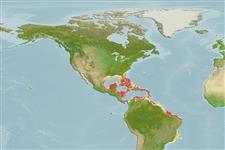>
Ovalentaria/misc (Various families in series Ovalentaria) >
Pomacentridae (Damselfishes) > Microspathodontinae
Etymology: Microspathodon: Greek, mikros = small + Greek, spatha = spathe + Greek, odous = teeth (Ref. 45335).
More on author: Cuvier.
Environment: milieu / climate zone / تغييرات عمق / distribution range
بوم شناسي
دريايي وابسته به آب سنگ; غير مهاجر; تغييرات عمق 0 - 120 m (Ref. 10797), usually 0 - 10 m (Ref. 7247). Subtropical; 33°N - 25°S, 98°W - 34°W
Western Atlantic: southern Florida (USA) and Bermuda through the Caribbean Sea to Brazil (Ref. 40101).
Size / Weight / سن
بلوغ: Lm ? range ? - ? cm
Max length : 21.0 cm TL جنس نر / بدون خواص جنسي; (Ref. 9710); common length : 15.0 cm TL جنس نر / بدون خواص جنسي; (Ref. 3139)
خارهاي باله پشتي (کل) : 12; شعاع نرم باله پشتي (کل) : 14 - 15; خارهاي باله مخرجي: 2; شعاع نرم باله مخرجي: 12 - 13. Tail bright yellow. Juveniles dark blue with transparent tail and electric blue spots on side (Ref. 26938). Adults dark yellowish brown, the edges of the scales darker (Ref 13442).
Body shape (shape guide): short and / or deep; Cross section: compressed.
A common (Ref. 9710) territorial species that inhabits coral reefs, juveniles usually encountered among branches of yellow stinging coral, Millepora. Adults are found in very shallow waters of coral reefs, usually near top of outer edge where there are caves, holes, and abundant fire coral (Ref. 26938). Feed primarily on algae but also on polyps of fire coral (Ref. 3139) and other invertebrate animal material (Ref. 13442). Juveniles occasionally pick parasites from other species of fish (Ref. 3139). Oviparous, distinct pairing during breeding (Ref. 205). Eggs are demersal and adhere to the substrate (Ref. 205). Males guard and aerate the eggs (Ref. 205). Occasionally marketed fresh (Ref. 3139). Have been reared in captivity (Ref. 35420).
Life cycle and mating behavior
بلوغ | تولید مثل | تخم ریزی | تخم ها | Fecundity | توزاد ( لارو)
Oviparous, distinct pairing during breeding (Ref. 205). Eggs are demersal and adhere to the substrate (Ref. 205). Males guard and aerate the eggs (Ref. 205).
Allen, G.R., 1991. Damselfishes of the world. Mergus Publishers, Melle, Germany. 271 p. (Ref. 7247)
وضعيت در فهرست قرمز IUCN (Ref. 130435: Version 2025-1)
خطر برای انسان ها
Harmless
استفاده انسانی
ماهي گيري – شيلات: معاش ماهیگیری; آكواريوم: تجاري
ابزارها
گزارش های ويژه
بارگيری XML
منابع اينترنتي
Estimates based on models
Preferred temperature (مرجع
123201): 26.1 - 28.2, mean 27.5 °C (based on 702 cells).
Phylogenetic diversity index (مرجع
82804): PD
50 = 0.5625 [Uniqueness, from 0.5 = low to 2.0 = high].
Bayesian length-weight: a=0.02239 (0.01256 - 0.03989), b=3.02 (2.86 - 3.18), in cm total length, based on LWR estimates for this species & (Sub)family-body (Ref.
93245).
Trophic level (مرجع
69278): 2.1 ±0.1 se; based on diet studies.
جهندگی (مرجع
120179): متوسط, كمينه زمان لازم براي دو برابر شدن جمعيت 4/1 – 4/4 سال (Preliminary K or Fecundity.).
Fishing Vulnerability (Ref.
59153): Low vulnerability (11 of 100).
🛈
Nutrients (Ref.
124155): Calcium = 44.9 [18.7, 74.8] mg/100g; Iron = 0.645 [0.367, 1.193] mg/100g; Protein = 18.7 [17.4, 19.9] %; Omega3 = 0.166 [0.091, 0.301] g/100g; Selenium = 17.6 [8.0, 37.8] μg/100g; VitaminA = 37.2 [7.7, 166.9] μg/100g; Zinc = 1.07 [0.66, 1.70] mg/100g (wet weight);
